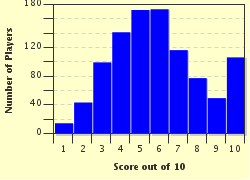Quiz Answer Key and Fun Facts
1. What's this crawling in my bunch of bananas?
Considered among the most dangerous in the world, this South American spider is often found in boxes of exported fruit, particularly BANANAS.
2. What's this crawling on my floor?
Also considered among the most dangerous in the world, this Australian spider has hard FANGS that, once embedded, literally have to be TORN OUT of the skin of its victim.
3. What's this crawling in my garage?
This dangerous spider is easily identified by a "RED HOURGLASS" on its abdomen.
4. What's this crawling up my arm?
This dangerous spider differs from most in that it has SIX EYES, instead of the customary eight, and a "VIOLIN-SHAPED" discolouration on its main body section.
5. What's this crawling on my back porch?
This dangerous spider, commonly found around the home, is often brown or dirty grey in colour with an outline of the "UNION JACK" flag on its back.
6. What's this crawling in my mailbox?
This very dangerous spider, native to ALL PARTS of Australia, hospitalizes almost 300 people every year.
7. What's this crawling in my bathtub?
The dangerous male of this small spider species, common in dry or arid parts of the U.S., is often identified by two mouth parts called "palpi", that resemble "BOXING GLOVES".
8. What's this crawling on my picnic table?
The more dangerous male of this species differs from the female in appearance: it has a RED HEAD, instead of black, and ELONGATED FANGS.
9. What's this crawling up my leg?
This large and dangerous species of TARANTULA is native to many parts of Asia.
10. What's this crawling in my tent?
This six-eyed spider, commonly found in DESERT AREAS of sub-Sahara Africa and South America, is considered by some experts to be the MOST DEADLY of them all.
Source: Author
benniebenbenny
This quiz was reviewed by FunTrivia editor
crisw before going online.
Any errors found in FunTrivia content are routinely corrected through our feedback system.

